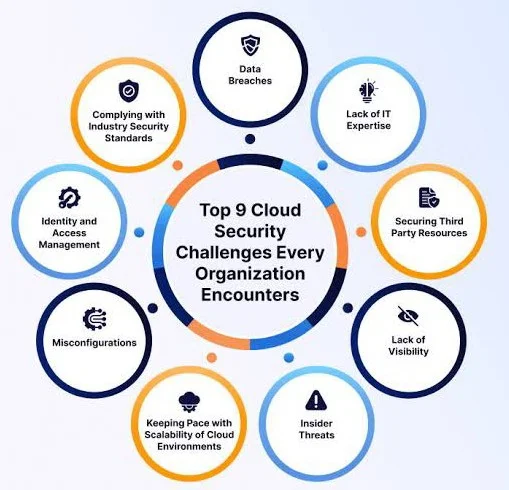Chapter 8: Cloud Security Concerns: Essentials of Cloud Computing
8.1 Introduction
As organizations increasingly migrate their workloads and data to the cloud, security becomes a paramount concern. While cloud computing offers numerous benefits—including scalability, cost-efficiency, and accessibility—it also introduces new vulnerabilities and threats. This chapter explores the critical cloud security concerns including data breaches and privacy issues, access control and identity management, and the importance of compliance with industry regulations and standards.
8.2 Data Breaches and Privacy Issues
8.2.1 What is a Data Breach?
A data breach is an unauthorized access and retrieval of sensitive data by a malicious actor or accidental exposure due to misconfigured systems. In cloud environments, breaches can involve customer information, trade secrets, intellectual property, financial records, and more.
8.2.2 Causes of Data Breaches in Cloud
-
Misconfigured cloud storage: Publicly exposed S3 buckets or blob storage.
-
Weak encryption: Poor or absent encryption for data at rest or in transit.
-
Insecure APIs: Vulnerable interfaces used to access cloud services.
-
Insider threats: Disgruntled employees or contractors accessing confidential data.
-
Poor access controls: Excessive permissions or lack of user role segregation.
8.2.3 Privacy Concerns
-
Data Sovereignty: Laws vary by country, and data stored in a different jurisdiction may be subject to foreign laws.
-
User Consent: Organizations must ensure they have user consent to collect and store personal data.
-
Shared Responsibility Model: Cloud providers secure the infrastructure, but data security is often the customer’s responsibility.
8.2.4 Mitigation Strategies
-
End-to-end encryption
-
Regular audits and vulnerability scans
-
Security patches and updates
-
Employee training and awareness
-
Zero-trust architecture
8.3 Access Control and Identity Management
8.3.1 Importance of Access Control
Access control ensures that only authorized users can access specific resources. It is a cornerstone of cloud security and directly ties into data protection and regulatory compliance.
8.3.2 Types of Access Control Models
-
Discretionary Access Control (DAC): Data owners determine who can access their data.
-
Mandatory Access Control (MAC): Access rights are regulated by a central authority.
-
Role-Based Access Control (RBAC): Access is assigned based on a user’s role within an organization.
-
Attribute-Based Access Control (ABAC): Access is granted based on attributes (e.g., time, location, device).
8.3.3 Identity and Access Management (IAM)
IAM refers to policies and technologies that ensure the right individuals access the right resources at the right times for the right reasons.
Key IAM Components in Cloud:
-
Authentication: Validating the identity of users through passwords, biometrics, or multi-factor authentication (MFA).
-
Authorization: Granting users permission based on their roles and policies.
-
Auditing: Monitoring and logging user activities.
-
Federated Identity: Allows single sign-on (SSO) across multiple systems, often used in hybrid or multi-cloud environments.
8.3.4 Best Practices
-
Implement MFA
-
Principle of Least Privilege (PoLP)
-
Regular review of access permissions
-
Use centralized IAM tools (e.g., AWS IAM, Azure Active Directory)
8.4 Security Compliance and Regulations
8.4.1 Why Compliance Matters
Organizations handling sensitive data must comply with national and international laws and industry-specific regulations. Non-compliance can result in hefty fines, reputational damage, and legal actions.
8.4.2 Common Cloud Security Regulations and Standards
| Regulation/Standard | Purpose | Applicable Industries |
|---|---|---|
| GDPR (General Data Protection Regulation) | Protects personal data of EU citizens | All industries |
| HIPAA (Health Insurance Portability and Accountability Act) | Secures health information | Healthcare |
| PCI-DSS (Payment Card Industry Data Security Standard) | Protects cardholder data | Financial services, e-commerce |
| ISO/IEC 27001 | Information security management system | All industries |
| SOC 2 (System and Organization Controls) | Evaluates cloud vendor’s data handling and privacy | Technology providers |
8.4.3 Cloud Provider Compliance
Major cloud service providers (CSPs) such as Amazon Web Services (AWS), Microsoft Azure, and Google Cloud undergo regular third-party audits and provide compliance certifications. However, the shared responsibility model requires clients to manage their own data security and configurations.
8.4.4 Strategies for Ensuring Compliance
-
Conduct risk assessments and compliance audits
-
Maintain documentation of security policies
-
Encrypt sensitive data
-
Utilize compliant cloud services
-
Monitor and log all activities for forensic investigation
8.5 Conclusion
Cloud security is a multifaceted challenge that requires a proactive approach to data protection, access management, and regulatory compliance. As data becomes increasingly decentralized, organizations must recognize their responsibilities under the shared security model. Implementing robust IAM systems, enforcing encryption, securing APIs, and adhering to industry regulations can significantly reduce security risks and build trust among customers.
8.6 Exercises
Q1. Define the shared responsibility model in cloud security and explain its importance.
Q2. List and explain three common causes of data breaches in cloud environments.
Q3. Describe Role-Based Access Control (RBAC) with a real-world example.
Q4. What are the key differences between GDPR and HIPAA?
Q5. Suggest five best practices for maintaining identity and access management in a cloud environment.
8.7 Case Study: Data Breach Due to Misconfigured S3 Bucket
In 2020, a financial services company suffered a massive data breach because their Amazon S3 storage bucket was left publicly accessible. This misconfiguration exposed thousands of customer records, including names, account numbers, and transaction details. The company faced severe reputational damage and legal consequences under data privacy laws.
Lesson Learned: Always review cloud storage configurations, restrict public access, and implement IAM controls.

Comments
Post a Comment
"Thank you for seeking advice on your career journey! Our team is dedicated to providing personalized guidance on education and success. Please share your specific questions or concerns, and we'll assist you in navigating the path to a fulfilling and successful career."